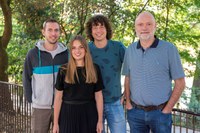3D-printed swabs “Made in UNamur”: less painful and equally effective for the molecular detection of SARS-CoV-2
The current supply of nasopharyngeal swabs may become insufficient to cover Covid-19 testing needs and be a critical bottleneck to the expansion of diagnostic capacity. 3D printing can be an effective solution to address supply shortfalls. Besides swab shortages, another drawback related to commercially available swab collection devices is the handling risk for laboratory staff, as well as the risk for cross-contamination between samples. Moreover, testing for coronavirus with a nasopharyngeal swab is invasive and feels uncomfortable for many patients.
Prof. Stéphane Lucas is head of the LARN laboratory (UNamur, Department of Physics), a research unit attached to both NISM and NARILIS institutes, and having a strong expertise in material sciences. In response to the coronavirus crisis, Stéphane Lucas proposed to develop an optimized sampling device using 3D printing and plasma surface treatment technologies, with three objectives in mind: to maximize the yield of collected material, to make the swabbing more comfortable for the patient and to enable a safer handling of samples. The project received the support of the F.N.R.S. through an Urgent Research Credit (SWAB IMPROVEMENT, project n°40002771).
During this summer 2020, researchers of the LARN have been working at the design and the clinical evaluation of the novel device. The clinical study, set up with the assistance of clinicians from the CHU UCL Namur, was performed at the UNamur and involved around 50 healthy volunteers. RT-qPCR analyses for SARS-CoV-2 were carried out following our in-house SANA protocol. Compared to the classical swabs which received an average note of 3/10 (very uncomfortable feeling, even painful), the “Made in UNamur” swabs were rated at an average of 6 to 7/10 (little discomfort). The results showed no difference in the yield of collected material. An additional benefit of the UNamur device is to allow the direct transfer of the content from the collection tube to an Eppendorf tube in one single operation without the need of pipetting. The 3D-printing technology allows the production of 50 to 100 swabs per day and provides the advantage of being an easily sharable process.
A next phase of the project is already underway and aims at further optimize the design of the swab head in order to increase scraping efficiency while maintaining a better comfort for the patient. Clinical evaluation of this second generation of swabs will be launched mid-October; The team plans to re-start recruitement of 50 healthy volonteers as of October 12!
The team is also considering how to valorize these achievements and is studying ways to obtain a certification from the Federal Agency for Medicines and Health Products (AFMPS).
SWAB IMPROVEMENT team
Prof. Stéphane LUCAS & Prof. Benoît MUYLKENS, UNamur, Project promoters
Dr. Sébastien PENNINCKX, UNamur, Project manager
Richard COOS, UNamur, Electromechanics engineer
Margot CARDINAL, UNamur, Lab technician
Prof. Thierry VANDER BORGHT, CHU UCL Namur, Supervision of the clinical study
Dr. Anaïs HANOT, CHU UCL Namur, Responsible for the swab sampling
Read also articles published on UNamur website, Avenir.net and La Meuse
PICTURE BY CHRISTOPHE SWIJSEN - From left to right: Richard Coos, Margot Cardinal, Sébastien Penninckx and Stéphane Lucas
 NAmur Research Institute for LIfe Sciences
NAmur Research Institute for LIfe Sciences


